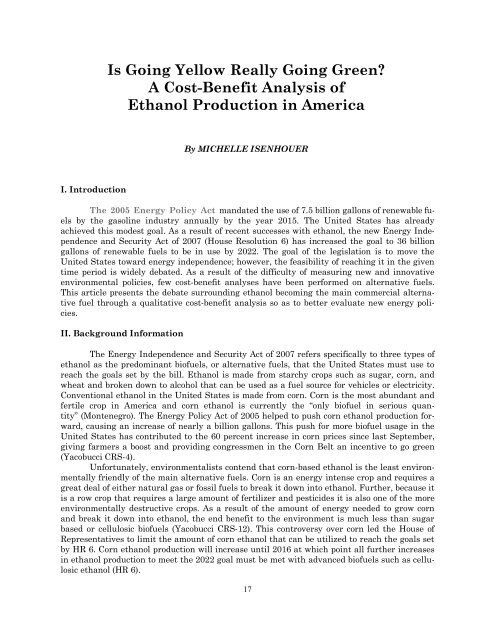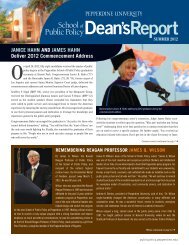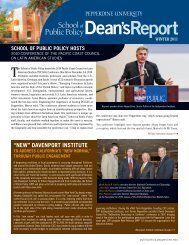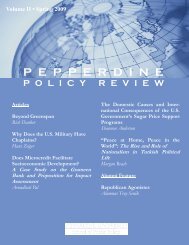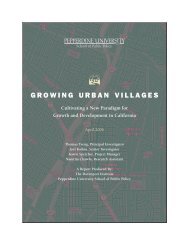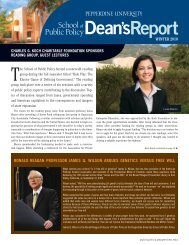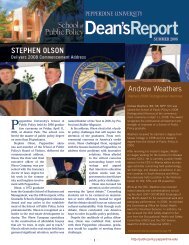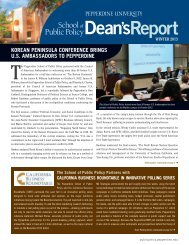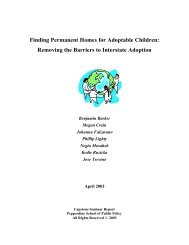Pepperdine University School of Public Policy
Pepperdine University School of Public Policy
Pepperdine University School of Public Policy
You also want an ePaper? Increase the reach of your titles
YUMPU automatically turns print PDFs into web optimized ePapers that Google loves.
Is Going Yellow Really Going Green?<br />
A Cost-Benefit Analysis <strong>of</strong><br />
Ethanol Production in America<br />
By MICHELLE ISENHOUER<br />
I. Introduction<br />
The 2005 Energy <strong>Policy</strong> Act mandated the use <strong>of</strong> 7.5 billion gallons <strong>of</strong> renewable fuels<br />
by the gasoline industry annually by the year 2015. The United States has already<br />
achieved this modest goal. As a result <strong>of</strong> recent successes with ethanol, the new Energy Independence<br />
and Security Act <strong>of</strong> 2007 (House Resolution 6) has increased the goal to 36 billion<br />
gallons <strong>of</strong> renewable fuels to be in use by 2022. The goal <strong>of</strong> the legislation is to move the<br />
United States toward energy independence; however, the feasibility <strong>of</strong> reaching it in the given<br />
time period is widely debated. As a result <strong>of</strong> the difficulty <strong>of</strong> measuring new and innovative<br />
environmental policies, few cost-benefit analyses have been performed on alternative fuels.<br />
This article presents the debate surrounding ethanol becoming the main commercial alternative<br />
fuel through a qualitative cost-benefit analysis so as to better evaluate new energy policies.<br />
II. Background Information<br />
The Energy Independence and Security Act <strong>of</strong> 2007 refers specifically to three types <strong>of</strong><br />
ethanol as the predominant bi<strong>of</strong>uels, or alternative fuels, that the United States must use to<br />
reach the goals set by the bill. Ethanol is made from starchy crops such as sugar, corn, and<br />
wheat and broken down to alcohol that can be used as a fuel source for vehicles or electricity.<br />
Conventional ethanol in the United States is made from corn. Corn is the most abundant and<br />
fertile crop in America and corn ethanol is currently the “only bi<strong>of</strong>uel in serious quantity”<br />
(Montenegro). The Energy <strong>Policy</strong> Act <strong>of</strong> 2005 helped to push corn ethanol production forward,<br />
causing an increase <strong>of</strong> nearly a billion gallons. This push for more bi<strong>of</strong>uel usage in the<br />
United States has contributed to the 60 percent increase in corn prices since last September,<br />
giving farmers a boost and providing congressmen in the Corn Belt an incentive to go green<br />
(Yacobucci CRS-4).<br />
Unfortunately, environmentalists contend that corn-based ethanol is the least environmentally<br />
friendly <strong>of</strong> the main alternative fuels. Corn is an energy intense crop and requires a<br />
great deal <strong>of</strong> either natural gas or fossil fuels to break it down into ethanol. Further, because it<br />
is a row crop that requires a large amount <strong>of</strong> fertilizer and pesticides it is also one <strong>of</strong> the more<br />
environmentally destructive crops. As a result <strong>of</strong> the amount <strong>of</strong> energy needed to grow corn<br />
and break it down into ethanol, the end benefit to the environment is much less than sugar<br />
based or cellulosic bi<strong>of</strong>uels (Yacobucci CRS-12). This controversy over corn led the House <strong>of</strong><br />
Representatives to limit the amount <strong>of</strong> corn ethanol that can be utilized to reach the goals set<br />
by HR 6. Corn ethanol production will increase until 2016 at which point all further increases<br />
in ethanol production to meet the 2022 goal must be met with advanced bi<strong>of</strong>uels such as cellulosic<br />
ethanol (HR 6).<br />
17


